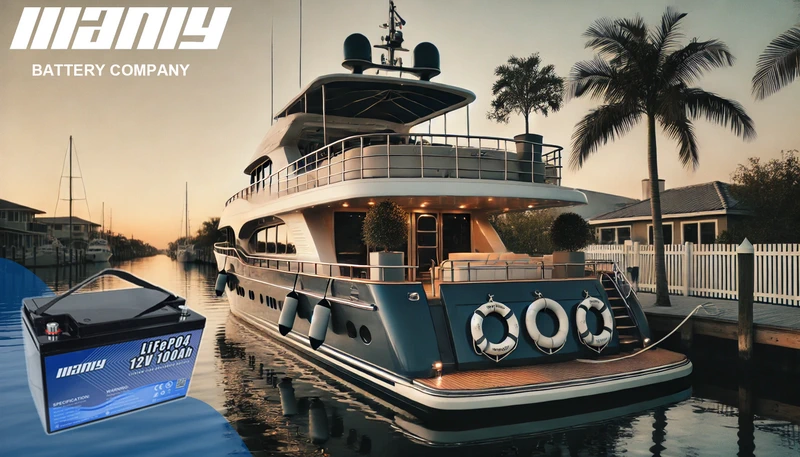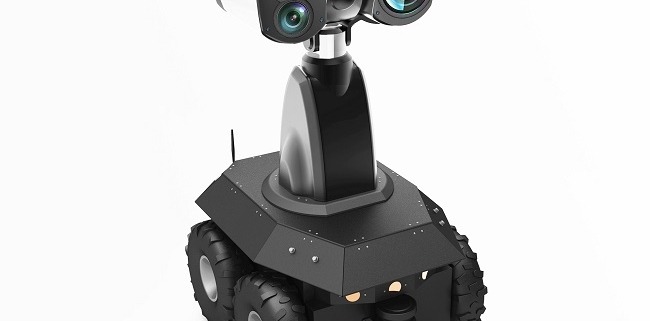What Type of Battery is a Marine Battery? A Detailed Breakdown
Table of Contents
- What Type of Battery is a Marine Battery? A Detailed Breakdown
- What is a Marine Battery?
- Different Types of Marine Batteries and Their Features
- The Best Choice: LiFePO4 Batteries for Marine Use
- Why LiFePO4 Batteries Are the Best Marine Batteries?
- Conclusion
- FAQ
- Hot Search
- Advantages of solar photovoltaic panel cleaning robot
- Kinds Of Lawn Mowers
- What Is An Intelligent Inspection Robot
Maintaining a consistent and dependable boating experience depends on choosing the right marine battery. Whether you use a trolling motor, start your engine, or run electronics, the appropriate battery type will make all the difference. The several choices for batteries make many sailors find it difficult to choose the right one.
This article will break apart lead-acid, AGM, gel, and LiFePO4 batteries as well as other types of marine batteries. You will learn every type in great depth, including its benefits, drawbacks, and optimal uses. By the conclusion, you will understand the reason LiFePO4 batteries are the best fit for marine applications.
What is a Marine Battery?
Designed especially to withstand adverse sea conditions, a marine battery is Unlike automobile batteries, which only provide short bursts of electricity to start an engine, marine batteries must deliver constant power for lengthy durations while tolerating vibrations, dampness, and temperature variations.
- Usually driven by its intended use, marine batteries are categorized:
- The starting battery runs the boat motor. It gives a brief, sharp boost but lacks long-term vitality.
- Deep-cycle batteries run constantly for lights, fish finders, and trolling motors among other equipment.
- A dual-purpose battery sometimes performs worse than dedicated beginning and deep cycle batteries, even if it aims to combine two uses.
These classification indicate the use of a marine battery, although the most important factor influencing battery performance is battery chemistry. Chemistry of a battery determines its general performance, longevity, efficiency, and maintenance requirements.
Different Types of Marine Batteries and Their Features
The several kinds of marine batteries are listed below, together with their characteristics:
Lead-Acid Marine Batteries
Lead-acid batteries have been used in marine conditions as they have been rather competitively priced and widely available for decades. These batteries chemically react with lead plates and sulphuric acid to generate power.
Flooded Lead-Acid (FLA) Batteries
Flooded lead-acid batteries are the most classic form. They demand consistent maintenance, including topped off distilled water. They are heavy, require ventilation, have a shorter lifetime than other battery types even if they are economically priced.
Sealed Lead-Acid Batteries
Lead-acid batteries sealed eliminate maintenance needs and are spill-proof. Two most widely used variants that improve performance over typical flooded lead-acid batteries are AGM (absorbed glass mat) batteries and gel batteries.
Advantages of Lead-Acid Marine Batteries
Lead-acid batteries are reasonably cheap and rather numerous. Their great starting current makes them worth using for engine cranking.
Disadvantages of Lead-Acid Marine Batteries
Lead-acid batteries need regular maintenance, weigh a lot, and charge slowly. Usually running for two to four years, their lifetime is short; they break down upon discharge below 50% capacity.
AGM (Absorbed Glass Mat) Marine Batteries
AGM batteries are spill-proof and maintenance-free by absorbing the electrolyte using fiberglass mats, therefore improving traditional lead-acid designs.
How do AGM Batteries Work?
By immobilising the electrolyte inside the glass mat, AGM batteries reduce the possibility of leaking and hence maximise power efficiency. Since this structure lets for better resistance to vibrations and faster charging periods, AGM batteries are a more durable replacement for flooded lead-acid batteries.
Advantages of AGM Marine Batteries
Zero maintenance and faster charging than other lead-acid models describe AGM batteries. Their lifetime is between three and six years, and they have more resistance to deep discharges.
Disadvantages of AGM Marine Batteries
AGM batteries remain heavier than lithium alternatives even with their superior performance. On a tight budget, they also appeal less to boaters since they cost more than flooded lead-acid batteries.
Gel Marine Batteries
Gel batteries use liquid electrolytes from a silica-based gel. Less leaks and greater deep discharge performance are made possible by this chemical composition.
How do Gel Batteries Work?
The gel-based electrolyte lowers chemical reactions, therefore reducing the possibility of overcharging or deep discharge. Applications needing constant, long-term power will find ideal use for these batteries.
Advantages of Gel Marine Batteries
Gel batteries resist high temperatures, maintain a longer lifetime than flooded lead-acid batteries, and require no maintenance.
Disadvantages of Gel Marine Batteries
The slow charging rate of gel batteries is its biggest drawback. Furthermore expensive than AGM and flooded lead-acid batteries are they are. Less forgiving than other battery kinds, overcharging can damage a battery permanently.
The Best Choice: LiFePO4 Batteries for Marine Use
The most intelligent and powerful marine batteries are LiFePO4 (Lithium Iron Phosphate). Unlike lead-acid batteries, which rely on chemical interactions between lead and acid, they offer constant and dependable power by means of lithium-ion technology.
Why LiFePO4 Batteries are Superior?
Among their most important benefits are LiFePO4 batteries’ extended lifespan. Lead-acid batteries run two to six years; LiFePO4 batteries can run ten years or more. Since they weigh up to 70% less than lead-acid batteries and are more easily handled, they also greatly improve boat performance.
Charging time offers still another major advantage. Five times faster charging of LiFePO4 batteries than with lead-acid batteries Unlike lead-acid batteries, which have to be kept above 50% charge, they also enable total discharges free from battery damage.
Are There Any Drawbacks to LiFePO4 Batteries?
The sole negative of LiFePO4 batteries is their starting cost. For seasoned sailors, however, they are the most affordable choice because of their long lifetime, fast charge times, and low maintenance needs.
Why LiFePO4 Batteries Are the Best Marine Batteries?
LiFePO4 batteries have long-term benefits above all other battery models, even if their initial expense makes many sailors unwilling to switch. Boats carrying LiFePO4 batteries had 30% longer running lifetime on electronic systems and trolling motors, according a study by marine engineers.
Savings in weight also improve performance. LiFePO4 technology lets a boat greatly reduce the weight of its battery, therefore enhancing fuel economy and general maneuverability. Boaters looking for dependability, fast charging, and long-lasting performance would best invest in LiFePO4 batteries.
Conclusion
The perfect sailing voyage depends on selecting the right marine battery. Though lead-acid, AGM, and gel batteries are still somewhat popular, none give the efficiency, lifetime, and long-term savings LiFePO4 batteries offer.
LiFePO4 batteries from MANLY Battery provide the finest answer if you want a dependable and high-performance marine battery. Their innovative lithium technology guarantees exceptional energy economy, therefore assuring that your boat keeps running without the trouble of regular replacements.
For premium-quality marine batteries, visit MANLY Battery today and experience the next generation of marine power solutions.
FAQ
1. Is a deep cycle battery the same as a marine battery?
Let’s clarify: a deep cycle battery and a marine battery aren’t the same, although they have similarities. Here’s why:
A deep cycle battery provides a steady power flow over an extended period. It’s designed for applications that need consistent energy, like golf carts, RVs, or renewable energy systems. These batteries are built to handle repeated discharges and recharges without losing performance.
On the other hand, a marine battery is specifically made for boats. However, marine batteries come in two types: starting and deep cycle. A starting battery delivers a quick surge of power to start the engine, while a deep cycle marine battery powers your boat’s electronics and other devices.
So, while some marine batteries are deep cycle, not all deep cycle batteries work as marine batteries. If you’re choosing a battery for your boat, ensure it’s designed for marine use to get the most reliable power.
2. What are the three types of marine batteries?
Marine batteries come in three main types, each serving a different purpose. Understanding their roles helps you pick the right one for your boat:
- Starting Batteries: Starting batteries provide a quick burst of power to start your engine. They’re all about delivering a high-energy jolt for a short time. These batteries are not designed to power other devices, so they focus only on getting your engine running.
- Deep Cycle Batteries: Need power for your boat’s electronics, trolling motor, or other accessories? Deep cycle batteries are your answer. They deliver steady, long-lasting energy and can discharge and recharge multiple times without losing capacity. Perfect for extended trips or when you’re off the grid!
- Dual Purpose Batteries: As the name suggests, dual purpose batteries combine the functions of both starting and deep cycle batteries. They give you enough power to start your engine and supply energy to your accessories. They offer versatility but may not provide as much power as a dedicated starting or deep cycle battery.
Hot Search
Marine Lithium Battery Battery Manufacturer
Hello
1. Can adapt to complex terrain and climate environment,
2. It has a clean monitoring platform and a diagnosis system, which can be remotely managed, and can facilitate operation and maintenance, and improve the degree of automation.
3. Waterless cleaning, with a cleaning speed of 20 meters per minute, to meet the cleaning problems of centralized photovoltaic modules with large areas, long distances and multiple environments.
4. Various cleaning methods can automatically remove snow and dust according to different usage requirements.
5. Highly clean, no harm to tempered glass, cleanliness can reach 99%.
Intelligent inspection machines are now widely used in various special tasks, such as subway stations, or in some line inspection tasks or fixed-point tasks. But what exactly is an intelligent inspection robot?
The inspection robot uses a mobile robot as a carrier, a visible light camera, an infrared thermal imager, and other detection instruments as a load system, and a multi-field information fusion of machine vision-electromagnetic field-GPS-GIS as the robot’s autonomous movement and autonomous inspection The navigation system uses an embedded computer as the software and hardware development platform of the control system.
There are many types of inspection robots, one of which is the line inspection robot, which has obstacle detection, recognition and positioning, autonomous operation planning, autonomous obstacle crossing, autonomous inspection of transmission lines and their corridors, inspection images and data The robot body has functions such as automatic storage and remote wireless transmission, ground remote wireless monitoring and remote control, online real-time power supply, background inspection operation management, analysis and diagnosis.
The intelligent substation inspection robot integrates core technologies such as uncooled focal plane detectors, trackless laser navigation and positioning, infrared temperature measurement, intelligent meter reading, image recognition, etc., and performs all-weather inspections, data collection, and video monitoring of power transmission and transformation equipment , Temperature and humidity measurement, air pressure monitoring, etc., to improve the safe operation of equipment in the transmission and substation. In the event of an abnormal emergency, the intelligent inspection robot can be used as a mobile monitoring platform instead of manual labor to find out equipment failures in time, reducing personnel safety risks.
This kind of robot operation is actually very simple. The substation intelligent inspection system is divided into three layers as a whole, which are front-end equipment, transmission part and back-end control center.
Front-end equipment: Intelligent inspection robot / Charging room / Fixed monitoring points, etc.
Transmission part: composed of network switches, wireless bridges and other equipment, responsible for establishing network channels between the base station layer and the intelligent terminal layer
Back-end part: by the robot backstage, hard disk video recorder, hardware firewall and intelligent control and analysis software.
In addition, there is also an indoor guide rail type intelligent inspection robot.
The indoor guide rail type intelligent inspection robot system realizes automatic identification of switch cabinet infrared temperature measurement, partial discharge detection, cabinet surface and protection device signal status indication, etc., relay protection room protection screen cabinet pressure plate status, air switch position, current terminal status, The device signal light indication and the fully automatic identification reading of the digital display instrument. The system adopts the guide rail sliding touch power supply mode to realize 24 hours uninterrupted inspection, and it can also customize the cycle and equipment for special inspections. And this kind of robot is better to operate. It can not only allow operation and maintenance personnel to use AR real-world monitoring technology, but also use smart inspection technology to set the system and perform regular, repetitive, and multiple task executions.







